Anti-personnel and grenade launchers
In March, the captain of the Yekaterininsky regiment, the staff captain M.Dyakonov arrived at the rifle range of the rifle officer school 1916 of the year to demonstrate their developments. He invented a rifle grenade, fired from a rifled mortar barrel. Mortirka was mounted on the muzzle of a Mosin rifle, created in 1891 year. Her desk had a caliber 41 millimeter and was made of steel pipe. M.Dyakonov's fragmentation grenade and a rifled mortar turned out to be the most successful developments, therefore, in December 1916, tests were conducted and about 6 million grenades and 40 thousand mortaros were ordered. They were even put into service, but mass production was never launched, since in March 1918, the industry was demobilized. In 20-s Dyakonov's grenade launcher adopted by the Red Army. For a decade, in the 20-30-ies, the author continuously conducted improvements, both the grenade launcher and ammunition for him. In Soviet times, the grenade launcher was already equipped with a tube and an additional charge. In addition, its shape has become more streamlined.
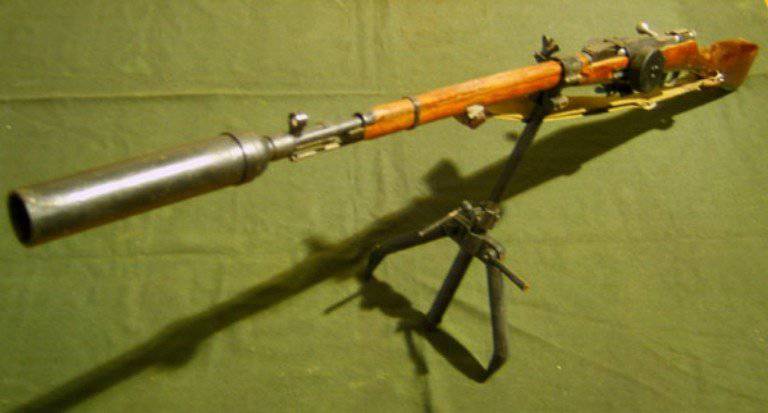
A rifle grenade launcher could reach the target at a distance from 150 to 850 meters, and the flight path of the grenades allowed them to get even behind cover. This weapon could be used both in defense and in the offensive. The assembled Dakonov grenade launcher weighed about 8 kilogram.
When firing, a grenade needs to be inserted into the barrel of the mortar, and to give it a spin on the barrel of the mortar there are three grooves. To make the rifle steady, use a bipod, the legs of which are placed on the surface. In addition, the holder of the rifle should also be attached to the bipod stand. The quadrant protractor, which is used for aiming at the target, is attached to the rifle with a clamp.
A rifle grenade is a small projectile whose weight does not exceed 370 grams. Its steel case is covered with a bottom tray. Along the body there is a tube through which the bullet passes. And inside it - a bursting projectile, which consists of an explosive in the number of 50 grams. In order to install a grenade in a combat position, you need to rotate a special remote drive. In order to increase the firing range, the grenade is equipped with an additional expelling projectile, which consists of a silk bag with an 2,5 gram of smokeless powder. The charge is located at the bottom of the projectile. And in order to protect the grenade from moisture, it is hermetically screwed into a special cap.
At the start of the 30s, Soviet gunsmiths took up the challenge of increasing the firepower of infantry troops. In 1934, the Taubin Design Bureau was created, which in 1937 was renamed OKB-16, and which began work on designing an automatic grenade launcher. The first model of the 1935 model of the year worked on the recoil of a free gate. For the first time, a magazine for 5 cartridges was used, which made it possible to increase the rate of fire. A special projectile was also created for this weapon - a shot of caliber 40,8 of millimeters with a flangeless sleeve. But, since this ammunition could not ensure reliable operability of automation, the designer was forced to completely change the design of the grenade launcher itself. The new model appeared in 1936-1938's. The automatics of the new grenade launcher worked on the recoil of a long barrel stroke with the barrel bore locked. The power supply of the weapon was carried out from a five-charge magazine, which was inserted from above into the gate box. Were developed and machines - tripod and wheel. The wheeled machine created by Nudelman was recognized as more successful. Therefore, it was proposed to use it for the modernized AG-2, and the grenade launcher's mass was approximately 40 kilograms, the rate of fire was 200 shots per minute, which made it possible to ensure successful solution of tactical tasks during combat.
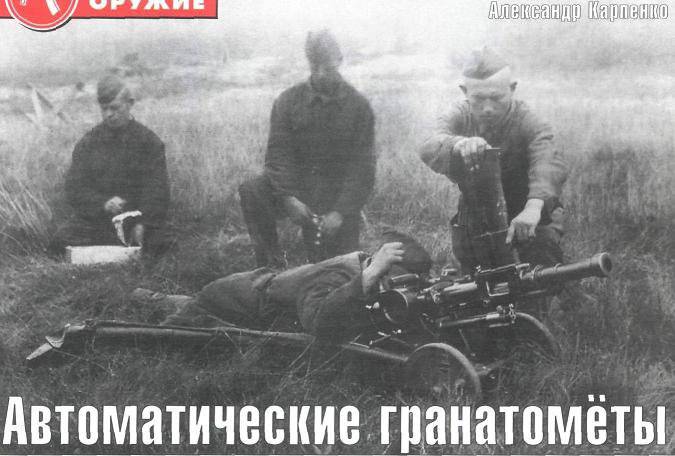
Originally, the AG-2 was planned to be used to enhance the firepower of the infantry. In addition, back in 1935, Taubin decided to mount a grenade launcher on a motorcycle in order to increase its maneuverability. However, this idea was not implemented.
By the end of 1938, the construction of the grenade launcher was completed. Its tests were carried out in January 1940 on the Karelian front, during which numerous defects were identified.
The grenade launcher was never put into service, and Taubin himself was arrested and convicted on charges of sabotage and sabotage. After 30 years, a weapon of this type was created, but its level was much higher.
In 1963, designer V.V. Rebrikov, under the direction of K.V. Demidov, at TsKIB MTR, prepared a draft of a compost grenade, which was intended for throwing from AKM. The grenade was shot from a mortar, which was under the barrel of the machine gun. Initially, the powder gases were discharged with the help of a blank cartridge and removal of mortar from a muzzle. Then - on the valve-peen. But, since both of these options did not fit, it was decided to equip the mortar with a trigger mechanism, after which it turned into a grenade launcher.
The grenade launcher was called JCG-40 "Iskra". In order to control the position of the weapon during firing from the shelter, the same position of the muzzle sections on AKM and Iskra was provided. It also allowed to fire over-caliber ammunition. The grenade launcher was equipped with a crane device for the release of powder gases during firing. During the discharge of gases, the speed of the grenade was about 55 meters per second, which made it possible to carry out hanging fire at a distance of about 80 meters. OKG-40 could punch armor at right angles to 50 millimeters thick. But at the same time, during the tests, it was found that when firing at an angle of 45, the OGN-40 degrees provided approximately 50 percent penetration. In 1970, all work on this project ceased, so this rifle grenade launcher was not accepted for service.
After the M203 rifle grenade launcher appeared in the US military, the Soviet command decided that it was necessary to have something similar. Development of the new grenade launcher was launched in the 1975 year. They were based on the technologies used in the process of working on Iskra. In 1978, the Soviet troops adopted the GP-25 “Koster” grenade launcher, which was planned to be used with AKM, AK-74, AKMS and AKS-74 assault rifles. Their production was established at the Tula Arms Plant.
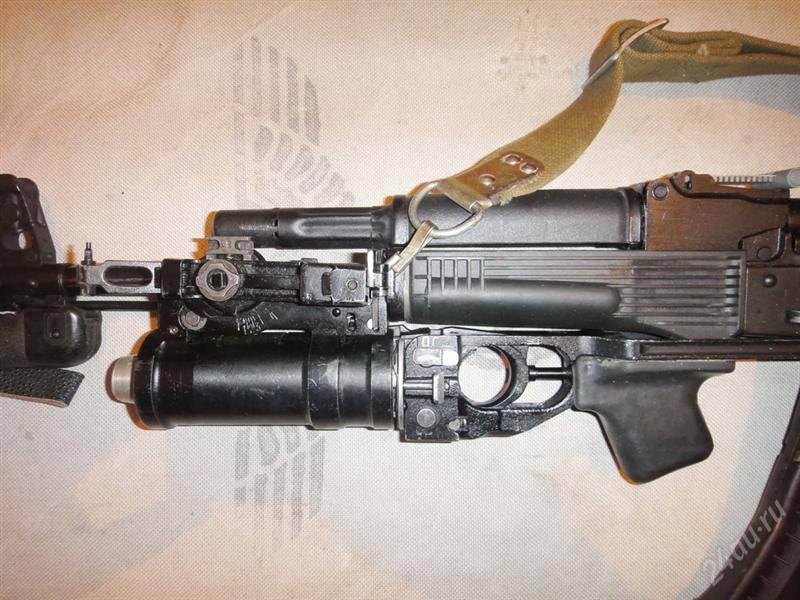
GP-25 has a barrel-threaded rifled system. For shooting, FOG-25 or VOG-25P frag grenade is used. In its composition there is a grenade and a propelling charge, which are held in the barrel by means of a spring-loaded lock. The grenade launcher is equipped with a self-propelled trigger mechanism with a trigger. The grenade launcher is mounted under the barrel and locked with a latch.
GP-25 is equipped with a mechanical sight, designed for direct or semi-direct guidance, allowing you to fire at a distance from 100 to 400 meters. Works most effectively with AK-74 and AKM machines. Charging grenade launcher with a muzzle of the barrel. If the shot is not fully reached into the barrel, the transmitting lever blocks the trigger, so shooting is impossible. In addition, if the grenade launcher is not fully connected to the machine, a special locking device is also provided for the firing mechanism.
With the help of grenade launcher GP-25 you can shoot from a prone position, from the knee, with an emphasis on the ground, from the shoulder. In order to defuse the grenade launcher, a special extractor is used.
In 1985, the military set the task of modernizing the GP-25. In 1987, a new model of a grenade launcher appeared, which was successfully tested. The grenade launcher was named "Obuvka" and in 1989 it was put into service. The main characteristics of the GP-30 is identical to the GP-25.
In order to improve the aiming conditions, the sight was moved to the right, which significantly improves performance. Also, this installation of the sight greatly simplifies its landing with fewer strikes. In addition, the plumb line, which was used for shooting at invisible targets, was removed from the sight. This is due to the fact that during the tests, the ineffectiveness of such shooting was proved. GP-30 also has no flag-type fuse. This is due to the fact that a fairly large force must be applied to the trigger hook, which virtually eliminates any possibility of an accidental shot.
In 2000, the design bureau of the Izhmash concern proceeded to the development of a new grenade launcher, called the GP-34. It was launched into serial production in 2005 at Izhevsk Arms Plant. This grenade launcher differs from its predecessors in lightness and compactness and is designed to destroy enemy personnel, which is located both in open areas and in open trenches and trenches. The firing range of the GP-34 is 100-400 meters.
It can be connected to AKM, AK-74, AKMS, AK-74М, AN-94, AK-103 machines. If necessary, it is possible to conduct firing from a machine gun with an installed grenade launcher. The sight is designed to carry out mounted and flat shooting. For GP-34, VOG-25 and VOG-25М shots with fragmentation grenades, VDG-25 with smoke grenades and VOG-25P and VOG-25М with “jumping” fragmentation grenades are used.
GP-34 was designed specifically for the Kalashnikov assault rifle, so its installation and removal does not require any extras. The design of the grenade launcher is reinforced, that is, when it is thrown at the concrete, it does not receive any notches and pricks. Also, the probability of misfires is almost equal to 0 due to the corrections to the trigger mechanism. In the case of a negative declination of the weapon, the grenade does not shift, the refinement of the aiming mechanism was carried out.
There is another very interesting development. In 1993, the development of a multi-shot revolver grenade launcher for VOG-25 and VOG-25P was started. A year later, six samples of this type were presented and submitted for testing. In real conditions, this grenade launcher was tested in Chechnya, after which it received the name WG-6. This type of weapon is simple. It consists of a block of drum-type barrels, sighting devices and a pipe with a handle and a lid, a body equipped with a power bar and an axle, a sliding stock and a trigger mechanism.
The body is made in the form of a disc-shaped box with a tubular barbell and an axis on which a winding spring is put on. The trunk block includes 6 mortars, which are connected by a sleeve and a faceplate. Mortar itself is equipped with 12 screw threads.
The back position of the drummer is provided by the charge itself. The charge, which is embedded in the front, is held by means of a spring-loaded lock. The trigger mechanism is almost no different from the GP-25, with the exception of the handle, and is self-cocking.
The pipe is used to install the front rubber grip, sighting devices, and is also protected from the powder gases for the left hand shooter. The composition of folding sights include a cylindrical front sight and a frame sight. Retractable butt is a steel pipe and shoulder rest with a shock absorber made of rubber.
Despite the fact that it is made easier than its foreign counterparts, but, nevertheless, can withstand any blows, it can be easily disassembled for lubrication and cleaning.

In the Soviet Union, another unique type of weapon was developed - the Silent D-shot carbine-propelled grenade launcher. Its development was carried out in the 70-ies of the twentieth century for the units of special forces of the army. The main objective of this weapon was to deliver preventive strikes on radar installations, headquarters, communications hubs, ammunition depots and fuel, and tactical missiles with nuclear warheads in the event of a “cold war” becoming a military conflict. Incendiary or high-explosive grenades of 30 caliber of millimeters (for destruction of equipment) and armor-piercing bullets of 9 caliber of millimeters for destruction of manpower were used for shooting. In order to ensure the secrecy of the application, the grenade launcher was made flameless and noiseless.
To date, the "Product D" is still in service with the special forces of the army, as well as special forces of the FSB, even though the new silent automatic grenade launchers "Canary" and "Silence" were released.
The weight of the cartridge is approximately 150 grams, and the length is slightly more than 9 centimeters. It was released two types of cartridges - "Phalanx" and "Mouthpiece". The mass of the grenade was 130 grams, its initial speed was about 110 meters per second.
The weapon itself is made in the form of a carbine with manual reloading using a longitudinal sliding gate and powered from a box-shaped detachable magazine. Shop used instead of the handle. In order to ensure higher accuracy of shooting, “Product D” is completed with a two-legged bipod.
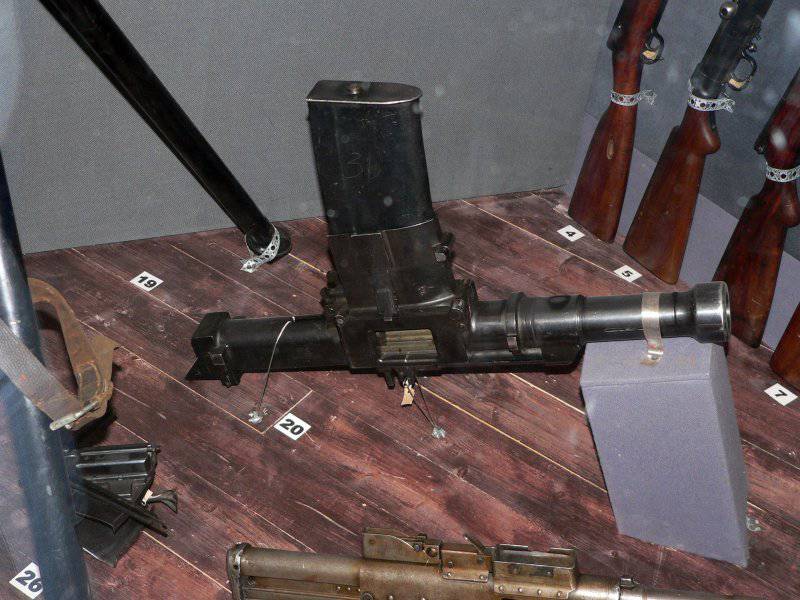
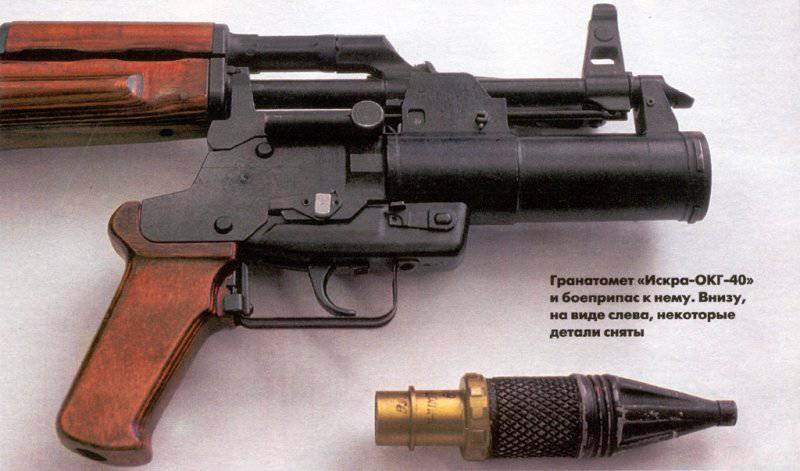
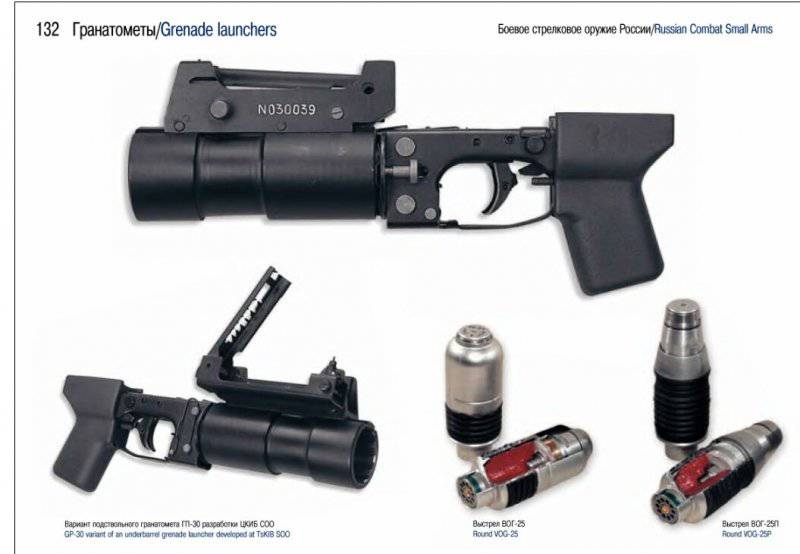
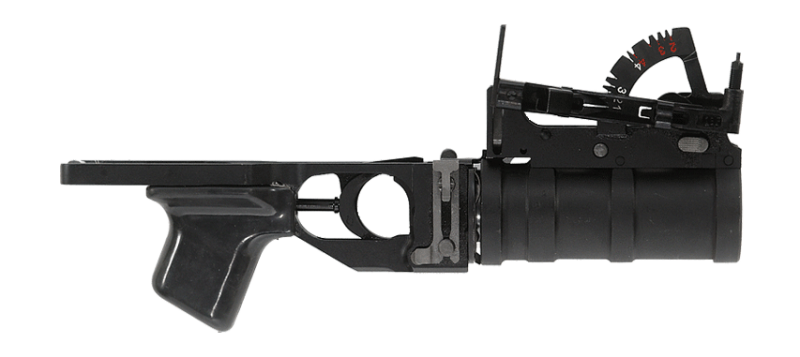
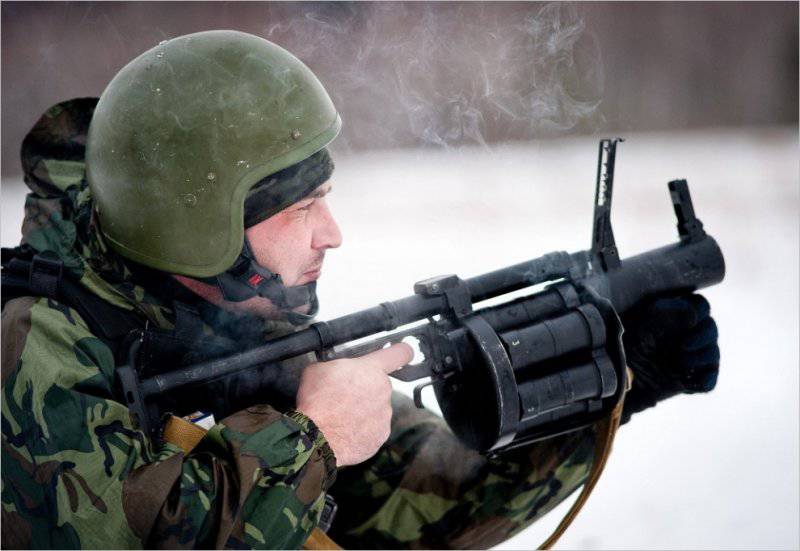
Information